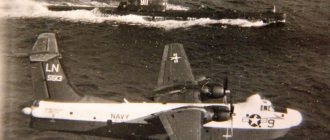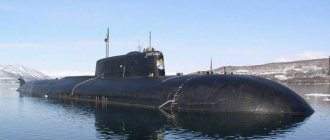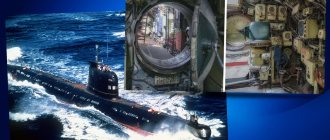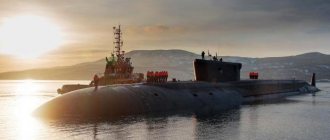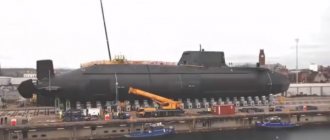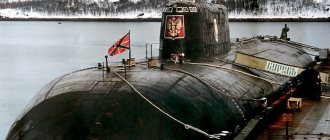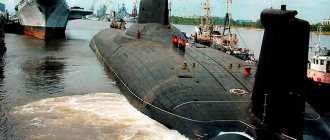The domestic Project 633 submarine was developed by the Central Design Bureau under the leadership of Z. A. Deribin. Subsequent activities on its creation were controlled by A. K Nazarov and E. V. Krylov. The model was a diesel-electric type of submarine, manufactured by order of the Council of Ministers of the Soviet Union No. 1454-808 dated 08/09/1955. During serial production, several dozen copies were produced, which were not only in service with the Soviet army, but also in other countries of the world.
History of creation
The trial project 633 submarine, the photo of which is shown above, was presented in the spring of 1955 in two versions. These variants received code names in the Navy database (Project 633 and I-633). For technical implementation, a special commission chose the second option.
The laying of the first prototype of the submarine under serial number 331 was carried out at the Krasnoye Sormovo plant in Gorky. Launching was carried out at the end of May 1958. Sea testing of the submarine was carried out from October 22 to December 20 of the same year. State tests took place in the next six months in the Black Sea. Later, the submarine received the duty number S-350 and was sent to the Northern Fleet for further inspection.
According to some reports, it was planned to build at least 500 boats of this series. In reality, only a little more than two dozen cars were built. Export versions were produced in the second half of the 60s of the last century.
Design features
The Project 633 submarine is a double-hull submarine; its dimensions are close to those of Project 613, and its hull configuration is similar to Project 611. The shape of the skeleton was chosen taking into account the peculiarities of operating the submarine along the White Sea, Baltic and Volga routes without the need to use batteries.
The submarine is configured to provide optimal seaworthiness when diving. The body itself is made of durable steel by welding, its length is 59.4 meters, the layout includes several cylinders of different diameters. As a protective coating, a material was used that corresponded to the technical documentation of TsKB-112 (1960), type - PL NPPRK-7.
The calculated protection against a medium nuclear explosion was:
- In a reinforced building at a distance of 1.6 kilometers.
- The main ballast tank is up to 1.6 km.
- In the superstructure - 1.0 km (air explosion).
Links[edit]
- ^ a b Ships of the USSR Navy, Vol. 1, part 2, Yu. Apalkov, St. Petersburg, 2003, ISBN 5-8172-0072-4
- ^ab [1] Archived June 19, 2006, at the Wayback Machine.
- ^ abcde "Chinese derivatives of the Romeo submarine". Archived from the original on 2013-06-28. Retrieved September 13, 2011.
- ↑
[2] Archived July 9, 2006, at the Wayback Machine. - John Pike. "Wuhan-class submarine - People's Liberation Army Navy". Globalsecurity.org. Retrieved December 28, 2011.
- https://www.mod.go.jp/e/publ/w_paper/pdf/2016/DOJ2016_1-2-2_web.pdf
- https://en.zamanalwsl.net/news/article/34567/
- "Panoramio - Photography 青岛海军博物馆 - 033型常规潜艇长城号(舷号号237)". web.archive.org
. 2016-10-27. Retrieved 21 April 21. - Coatepeque (05/07/2012). "China Defense Blog: Great Wall 349 (Type 033) SS Class" Romeo "out of service". China Defense Blog
. Retrieved 21 April 21. - 网易 (2020-05-10). "公岛,走进退役的海军 279潜艇,揭开潜艇内部的神秘面纱". www.163.com
. Retrieved 21 April 21. - "微博搜索". s.weibo.com
. Retrieved 21 April 21. - Coatepeque (05/07/2012). "China Defense Blog: Great Wall 349 (Type 033) SS Class" Romeo "out of service". China Defense Blog
. Retrieved April 19, 2022. - Coatepeque (05/07/2012). "China Defense Blog: Great Wall 349 (Type 033) SS Class" Romeo "out of service". China Defense Blog
. Retrieved April 19, 2022. - "Lushun Submarine Museum Guide - Must-See Attractions in Lvshunkou District - Nearby Lushun Submarine Museum Recommendations". TRIP.COM
. Retrieved 21 April 21. - Inc. Depositphotos. "Russian submarine S-49 in Sevastopol". Depositphotos
. Retrieved 21 April 21. - "The last Bulgarian submarine is now open to the public as a museum". bnr.bg.
_ Retrieved 21 April 21.
Encyclopedia of warships, from World War II to the present day
, General Editor Robert Jackson.
Engines
The Project 633 Romeo submarine is equipped with a power plant similar to analogue No. 613 with a pair of propeller shafts. Diesel engines are produced by the Kolomna plant, have a power of two thousand horsepower, the number of revolutions per minute is 500. The design of two-stroke units is standard action with direct-flow valve-type purge and a compressor-free six-cylinder block.
The unit is blown by a pair of rotary blowers. Stable operation of the propulsion unit is guaranteed when water waves are up to four points on board with the flow of up to 400 liters of water (at a minimum design speed). The propulsion unit also includes two electric rowing motors PG-101 (1350 “horses”, 420 rpm). Their configuration is units with rotating frames, water cooling of bearings and a pair of anchors. Additionally, two economical electric motors with a power of 50 kW, developing 420 rpm, were used.
Mechanical part
The mechanical block of the Project 633 diesel submarine has two low-noise propellers with six blades. The variable pitch of the elements is 1600 mm, they rotate in ring nozzles, replacing the unsuccessful experimental four-bladed predecessors.
The submarine is controlled using a guide, stern and bow rudders. They are equipped with a hydraulic controller activated from a central control. The spare drive is electric, aggregated with the stern horizontal rudders. Control of this unit is possible from the running bridge in the superstructure. Here the steering wheel has a mechanical connection with the operating mechanism. The energy unit consists of 224 batteries, combined into two groups of 112 pieces.
Rescue system and weapons
The Project 633 submarine is equipped with rescue equipment, including torpedo tubes. They allowed the crew with special equipment to leave the submarine from a depth of up to 120 meters. Evacuation was carried out through airlock. From depths of up to 200 meters, the crew rescue operation was carried out using a special bell from the stern. The central post and wheelhouse also made it possible to evacuate from depths of up to 100 meters with ISP equipment. To extinguish fires, the submarine is equipped with an air-foam system of the VPL-52 type.
The crew of the Project 633 boat consists of 52 people, the number of sleeping places is 55, the average living area in the compartments is 0.8 square meters. m, volume - about 9 cubic meters. Submarine armament:
- six bow torpedo launchers of 533 mm caliber;
- a pair of similar guns at the stern;
- combat reserve - 14 torpedoes;
- firing control - PUTS "Leningrad-633";
- drive of deep torpedoes - manual type.
Project 633 (NATO - “Romeo”).
Modifications: 633L, 633RV, 633KS.
1. Number of submarines of the project: 20.
2. Project image:
After repairs in the 80s, the submarine's deckhouse fence (bow section) was modernized. Such changes were made on the S-37, S-128, SS-350, three Syrian submarines, two Algerian submarines and two Bulgarian submarines.
3. Project composition:
| Ship name | Factory number | Dates | Notes | |||
| bookmarks | descent | entry into service | ||||
| BITTER: (N 112) (20) | ||||||
| 1 | S-350 | 331 | 22.10.1957 | 30.05.1958 | 31.08.1959 | 02/11/1962 - sank, raised 1969 - mod. on ave. 633L 08/03/1977 - trans. V SS-350 1982 - transl. |
| 2 | S-351 | 332 | 31.01.1958 | 18.08.1958 | 06.11.1959 | 1967 - before. Egypt 1967 - trans. at 766 197? — per. at 846 |
| 3 | S-352 | 333 | 30.03.1958 | 25.09.1958 | 31.10.1959 | 1967 - before. Egypt 1967 - trans. at 755 197? — per. at 843 |
| 4 | S-353 | 334 | 14.05.1958 | 30.11.1958 | 26.12.1959 | 1966 - before. To Egypt 1966 - trans. at 733 197? — per. at 831 |
| 5 | S-354 | 335 | 14.07.1958 | 10.01.1959 | 30.11.1959 | 1966 - before. To Egypt 1966 - trans. at 744 197? — per. at 840 |
| 6 | S-32 | 341 | 28.08.1958 | 30.08.1959 | 31.12.1959 | 1966 - before. To Egypt 1966 - trans. at 7?? 197? — per. at 834 |
| 7 | S-34 | 342 | 18.10.1958 | 14.06.1959 | 31.12.1959 | 1966 - before. To Egypt 1966 - trans. at 7?? 197? — per. at 837 |
| 8 | S-36 | 343 | 29.11.1958 | 27.09.1959 | 30.09.1960 | 1986 - before. Bulgaria 1985 - trans. in “Glory” (No. 84) 2022 - museum in Bulgaria |
| 9 | S-37 | 344 | 25.01.1959 | 10.10.1959 | 31.03.1960 | 1987 - mod. theme "Hertz-633" |
| 10 | S-38 | 345 | 14.03.1959 | 30.11.1959 | 23.09.1960 | 1983 - before. Bulgaria 198? — per. in “Hope” (No. 83) |
| 11 | S-53 | 351 | 29.07.1959 | 02.03.1960 | 31.12.1960 | 1985 - before. Syria |
| 12 | S-101 | 352 | 01.10.1959 | 15.04.1960 | 21.12.1960 | 1985 - before. Syria |
| 13 | S-212 | 353 | 29.11.1959 | 31.05.1960 | 21.12.1960 | 1973 - before. Bulgaria 197? - No. 42, then - N92 "Dimitrovsky Komsomol" 198? |
| 14 | S-128 | 354 | 11.03.1960 | 20.07.1960 | 29.12.1960 | 1978 - mod. on ave. 633KS 07/26/1991 - transl. |
| 15 | S-4 | 355 | 14.06.1960 | 17.12.1960 | 18.09.1961 | 1987 - before. Syria |
| 16 | S-7 | 361 | 25.11.1960 | 28.02.1961 | 17.09.1961 | 1983 - before. Algeria 1983 - trans. V № 011 |
| 17 | S-11 | 362 | 25.11.1960 | 15.04.1961 | 30.09.1961 | 1982 - mod. on ave. 633РВ 1982(?) - trans. |
| 18 | S-28 | 363 | 29.12.1960 | 21.06.1961 | 23.12.1961 | 1982 - before. Algeria 1982 - trans. V № 010 |
| 19 | S-49 | 364 | 29.03.1961 | 27.07.1961 | 31.12.1961 | 1991(?) - mod. on ave. 633РВ 1991(?) - trans. |
| 20 | S-57 | 365 | 23.05.1961 | 20.08.1961 | 27.12.1961 | 1973 - before. Bulgaria 197? - No. 41, then - N91 "Leninsky Komsomol" 198? |
4. Project history:
Submarine project design 633
was started according to the CM Resolution No. 1454-808 of 08/09/1955. The design was carried out in TsKB-112, the chief designer of the project was Z.A. Deribin, the deputies were A.K. Nazarov and E.V. Krylov, the main observer from the Navy was I.I. Chufrin.
In April 1955, the preliminary design studies of the project were completed and presented for consideration in two versions: one according to the specifications issued by the Criminal Code of the Navy, and the second “initiative” ( I-633
) with improved technical specifications. The developments were approved by the leadership of the Navy and SMEs. As noted in the conclusion of the Criminal Code of the Navy when considering pre-design studies in May 1955, “the proposed option is a completely new project for a medium-sized submarine.” In relation to this option, the TTZ was also revised.
Technical design of the submarine project 633
was approved by resolution of the Council of Ministers No. 1117-580 of August 15, 1956.
Project submarine 633
double-hulled, in its main dimensions it is close to the submarine pr.
613
, but in the nature of the contours it most closely corresponds to the submarine pr.
611
, in which the shape of the midsection is close to a circle. The contours of the submarine's hull are mainly subordinated to ensuring greater propulsion in a submerged position due to surface characteristics.
The wheelhouse and its fencing are made of relatively small dimensions and a streamlined shape (due to some constraint on the navigation watch) - to reduce resistance when moving in a submerged position.
The dimensions of the boat were designed taking into account the possibility of transportation along the Volga-Baltic, Volga-Don and White Sea-Baltic waterways in floating docks. Before the reconstruction of the Mariinsky system on the Chernovets-Vytegra section, transportation of boats was provided in special lightweight docks pr.768 with maximum unloading of boats, as well as in docks pr.28K with the battery removed.
The robust hull is divided into seven compartments by six watertight bulkheads. The following main equipment is located in the submarine compartments.
The first compartment (torpedo) contains torpedo tubes, spare torpedoes or mines on special racks, a torpedo loading hatch, 13 berths for the crew, drives for the bow horizontal rudders and capstan, and an emergency post for blowing out the main ballast systems.
The second compartment (battery) contains: one group of batteries and tanks for distilled water, a commander’s cabin, two double cabins and an officer’s wardroom, a radio communication room, a washroom, a battery machine, 5 high-pressure water cylinders and a fresh water tank.
In the third compartment (central post) there are: radar, hydroacoustics and navigation rooms with equipment, control posts for rudders, immersion and ventilation, control of the trim system, VVD and VSD stations, PUTS equipment, automatic voltage regulator and gyrocompass.
In the hold of the central post there are: a control station for the bilge system and the main drainage pumps, a pumping unit for the hydraulic system, log equipment, a provision storeroom with a refrigeration unit, a code post, a latrine, fresh water and dirty water tanks.
In addition, in the central post there are lifting and mast retractable devices for the frame antenna, the VAN-C antenna, the “Nakat” station, a periscope attack and an anti-aircraft, lifting and rotating device for the “Flag” antenna station.
The fourth compartment (battery) contains: the second group of batteries and tanks for distilled water, a wardroom and a cockpit for privates and petty officers with 20 berths, galley and shower rooms, three VVD cylinders, a battery machine and a remote control for diesel engines, as well as a tank of clean oil.
The fifth compartment (diesel) contains: two 37D engines with auxiliary mechanisms and pipelines, shaft lines and a second diesel control station. In addition, the compartment contains; electric compressor, electric fans for general ship and battery ventilation, air conditioning system, circulating and clean oil tanks, waste fuel tank and dirty water tank.
The sixth compartment (electric motor) contains: two main propulsion electric motors “PG-101” with control panels, two electric motors for economic propulsion “PG-103” and their control panel, shafting lines with couplings, two three-berth cabins for petty officers and enlisted personnel, a waste cylinder latrine, clean oil tank and dirty water tank.
The seventh compartment (aft torpedo) contains: torpedo tubes with pipelines, a device for storing torpedoes, an entrance hatch, four hanging berths, a bilge pump “2P-1” and a latrine with a washbasin, tanks - trim and annular gap, as well as a fresh water tank .
Durable welded body, made of high-strength steel AK-25. The robust body, 59.4 m long, consists of cylinders (with a diameter of 5300 mm in the area of the central post and 4900 mm in other areas) and truncated cones in the end compartments.
Vertical, stern and bow horizontal rudders of the balancing type, welded structure, streamlined shape. The vertical rudder and horizontal rudders are controlled by a hydraulic drive from the central control post. An electric drive is provided as a backup means of controlling the stern horizontal rudders. Switching from hydraulic to electric drive and control of the steering wheels using an electric drive is carried out from the central control panel. Control of the vertical rudder in surface mode is provided from the bridge, by means of a mechanical drive to the manipulator in the central control room.
To ensure life support and rescue the crew from a sunken submarine, the last three shelter compartments are fenced off with strong spherical bulkheads, tested for 20 kgf/cm2 on the concavity side and 7 kgf/cm2 on the convex side.
The torpedo tubes are equipped with a special system that allows the crew in ISP equipment to exit from depths of up to 120 meters, a method for locking the tubes and a method for flooding the compartment from a depth of up to 100 meters.
The central post and a durable wheelhouse, designed as an airlock, ensure the exit of the team in ISP equipment from depths of up to 100 meters.
The boat provides the ability to rescue the crew from the stern of the boat using a special bell from depths of up to 200 meters, which is new compared to previous projects.
The fuel and replacement system consists of fuel tanks with a useful capacity of 144.03 m3 and fuel and ballast tanks with a useful capacity of 155.12 m3.
According to the project, the calculated safe radii of submarine hull structures during explosions of a medium-caliber atomic bomb are:
- during an underwater explosion for a pressure hull - 1600 m, for the main ballast tank - 1100-1600 m;
- with an air explosion for the main ballast tank - 1390-1850 m, for the superstructure - 1900 m.
The robust hull houses 8 torpedo tubes of 533 mm caliber. Six bow torpedo tubes are located in two vertical rows parallel to the centerline plane of the submarine, and two aft ones are located symmetrically relative to the centerline plane, with an opening angle between the tube axes of 3°.
Loading of torpedoes and mines into submarines is carried out using a torpedo-mine-loading device, which ensures loading of a complete set (14 torpedoes) in 10 hours, excluding the time it takes to prepare the boat to receive ammunition. The loading time for a full set of mines (28-16 minutes into devices and 12 into racks) is 9 hours.
On PL Ave.633
introduced a standard VPL-52 air-foam fire extinguishing system and high-speed pressure-raising valves in remote-controlled compartments. We used the new Leningrad-633 control system, which, when working together with the Arktika-M GAS, helped solve fundamentally new problems of launching an attack.
To reduce noise on the submarine, in particular, foundations with a rubber vibration-damping coating were installed.
Innovations introduced into the project, as a rule, required experimental testing. The technical project documentation provided for the implementation of about two dozen experimental works, among them the development and testing of the following devices and components:
— telescopic lift for periscopes (instead of a chain hoist):
— petal gas exhaust nozzle of the RDP device:
— water pressure reducing valve with a pressure drop from 30 to 3 kg/cm2 and with a constant flow rate;
— safety valve of the RDP device;
— stern tube seal of a new design;
— TA fast reloading devices;
— tank designs for bubble-free torpedo firing (BTS);
— a new design of the torpedo-loading hatch with a torsion bar closing mechanism.
In addition, some structures and devices were subject to manufacturing and preliminary (before installation on the ship) testing. Among them were the following;
— tire-pneumatic coupling for economic travel;
— distribution column for high-pressure air pressure and emergency purge;
— small-sized gearbox with globoid gearing (for the capstan and kingstons of the Central City Hall);
— sickle-shaped strong intercompartment bulkheads 51 and 93 sp.;
— durable (sluice) cabin;
— bulkhead clinker valves;
— automatic valve for automatic switching to power from the emergency accumulator unit when the pressure in the main accumulator drops.
It was necessary to test the special system provided for the TA, which ensures the exit of personnel in ISP equipment by locking the device or by flooding the compartment. During operation, the operation of rescuing personnel from compartment VII was subject to verification using a diving bell, for the reception of which a special design was provided - a coaming platform.
On PL Ave.633
The serial system PUTS "Leningrad-633" was installed. The torpedo firing data generated by the Leningrad-633 PUTS system (the movement of torpedoes in the direction and the nature of the zigzag) are automatically and continuously transmitted to the torpedo compartments and installed in the torpedoes located in the tubes of the devices by control drives for gyroscopic devices (UPM-E). Setting the travel depth on torpedo gyrostats is done manually from the compartment using the “PUG” drive. The operating range of the CPTS is up to 100 cables (18.5 km).
Propellers with fairings rotate in nozzles. The propellers are six-blade, low-noise, variable pitch, with a diameter of 1.6 meters. The project provided for the possibility of installing four-blade propellers. Such propellers were installed on the second submarine pr.633 - “S-351”
and showed unsatisfactory results.
The boat's crew consists of 52 people, including 9 officers. There are a total of 55 sleeping places on the ship. The average free area per person in residential compartments is 0.8 m2, volume -9 m3.
Head submarine "S-350"
(factory No. 331) was laid down on slipway No. 3 on October 22, 1957, launched on May 30, 1958. The boat underwent factory sea trials from October 22 to December 20, 1958. State tests of the
“S-350”
were carried out from December 21. 1958 to 08/31/1959 in the Black Sea, and then continued in the Northern Fleet.
During the tests, fuel was received from the tanker "Seima" onto the submarine "S-350"
underway at a tanker speed of 6 knots, sea state 2-3 points. A total of 75.2 tons of fuel was received in 1 hour 40 minutes. The estimated time for receiving fuel into all fuel and ballast tanks (252 tons) is 6 hours 05 minutes.
During the tests, 18 torpedoes of the 53-56, ET-56, ET-46 and 53-39MP types were fired. All shooting went smoothly.
The reloading time for six torpedo tubes with ET-46 torpedoes is 40 minutes, with torpedoes of other types - 70 minutes, instead of 20 minutes according to the project.
During the tests, two-way communication was carried out "S-350"
with communication centers of the KBF (830 miles), KKF (720 miles) and Northern Fleet (1750 miles). The communication results are good. In addition, communication via a six-meter whip antenna with the communications center of the Pacific Fleet (Vladivostok) was tested, the results were good.
Submarine speed in RDP mode: minimum 5 knots with one diesel engine, 10 knots with two diesel engines. The disadvantage of the RDP is the intake of sea water (up to 400 l) at a speed of 8-10 knots with a sea state of 4 points.
Results of tests of radar and hydroacoustic stations.
Radar "Flag" for the destroyer Project 56: submerged submarine - 120 cables (22.2 km).
Search station "Nakat" for the destroyer pr.30-bis ( "S-350"
under the periscope); when the Reef station is operating - 150 cables (27.8 km);
when the Zalp station is operating - 220 cables (40.7 km); the same for an aircraft with a radar ( “S-350”
on the surface) 252-300 cables (46.6-55.5 km);
Hydroacoustic station "Arktika-M":
a) on the cruiser Project 68, moving at a speed of 20 knots, when maneuvering a submarine at a depth of 50 m at a speed of 12.5 knots: noise direction finding range in automatic tracking mode - 125 cables (23.15 km), echo direction finding range (range measurements) — 41 cabs (7.6 km);
b) on the destroyer Project 56, moving at a speed of 20 knots, when maneuvering a submarine at a depth of 80 m at a speed of 5.5 knots: noise direction finding range - 100 cabs (18.5 km), echo direction finding range - 29 cabs (5, 4 km).
The tests revealed the ineffectiveness of the Tuloma all-round hydrological station. On its screen it is almost impossible to distinguish a direction-finding target from false targets (lights) created by hydrodynamic and noise interference. By the decision of the Deputy Commander-in-Chief of the Navy on November 15, 1958, the Tuloma station was not accepted for service, and its further development was stopped.
With regard to the technical provisions provided for.633
possible modernizations, not all of them were implemented during serial construction.
However, other upgrades were carried out during construction, some of which required additional development work. For example, the installation of a demagnetization device required R&D to study the nature of the formation of the submarine’s magnetic field. In particular, the magnetic laboratory of the USSR Academy of Sciences (director - Professor E.I. Kondorsky) was involved in the development work, for which two magnetic models of the submarine pr. 633
on a scale of 1:12.5 were designed and built.
In 1960, TsKB-112, together with a number of industry institutes, developed drawings and design documentation for the installation of an anti-hydrolocation coating of the NPPRK-7 type on a serial submarine pr.633
(No. 344). The work was carried out according to the specifications of the Acoustic Institute of the USSR Academy of Sciences named after. N.N. Andreev and under his scientific leadership (topic leader - V.V. Tyuteknn).
After the completion of the construction of the entire series, the Lazurit Central Design Bureau developed a technical design for an experimental submarine pr. 633L
(GK E.V. Krylov).
The S-350
was re-equipped according to this project in 1967-1969 (to study the streamlining of the hull and test new hydroacoustic stations).
According to the drawings developed by SPMBM Malachite, two submarines were re-equipped on Project 633RV
- to test the system of firing from 650 mm caliber TA with new types of torpedoes.
In the bow of the boat they received a superstructure with two 650-mm torpedo tubes for testing new torpedoes. The test results made it possible to test the missile-torpedo system for a new generation submarine. S-128
submarine was modernized according to project
633KS
(in some sources
“project 06333” ) for testing the Granat missile launcher.
Project 633 were transferred to the fleets of other countries. Egypt - 6 submarines, Bulgaria - 4 submarines, Syria - 3 submarines and Algeria - 2 submarines. Some sources erroneously claim the construction of 22 Project 633
(also
S-6
and
S-9
).
According to Soviet documentation, Project 633
(
Project 031 ) were built in China (12 submarines, some sources indicate that the first 3 submarines were assembled in the USSR, and 9 submarines were built from sections built in the USSR), and later according to a modernized project ( Project 033 – Improved Romeo
) in China (72(71?) submarines, of which 7 submarines are for the DPRK and 6 submarines are for Egypt) and the DPRK (16(15?) submarines).
5. Project diagram:
6. Tactical and technical data of the project:
| displacement | ||
| surface normal: | 1328 tons | |
| surface with increased fuel reserve: | 1478 tons | |
| positional: | 1644 tons | |
| underwater: | 1712 tons | |
| travel speed | ||
| full surface: | 15.31 knots | |
| economic surface: | 9.2 knots | |
| full underwater: | 13.18 knots | |
| economic underwater: | 2.14 knots | |
| in RDP mode at full speed: | 10.0 knots | |
| cruising range (at cruising speed, knots) | ||
| in the surface position with increased fuel supply: | 5000 (15), 14590 (9) miles | |
| in the surface position with normal fuel supply: | 2400 (15), 7400 (9) miles | |
| submerged: | 14 (13) miles | |
| in a submerged position under EH electric motors: | 195 miles at full speed, 300 miles at economy speed | |
| in RDP mode: | 4400 (8) miles (9150 (8) miles with extended fuel capacity) | |
| immersion depth | ||
| limit: | 300 meters | |
| working: | 270 meters | |
| shipbuilding elements | ||
| length: | 76.68 meters | |
| width: | 6.72 meters | |
| average draft: | 5.07 meters | |
| construction type: | double-hull | |
| weapons | ||
| 533 mm stern torpedo tubes: | 2 | |
| 533 mm bow torpedo tubes: | 6 | |
| total number of torpedoes: | 14 | |
| number and type of mines (instead of torpedoes): | 28 (MDT) | |
| power plant | ||
| type: | diesel-electric | |
| quantity x power of diesel engines, hp: | 2 x 2000 hp (type 37D) | |
| quantity x power of motor, hp: | 2 x 1350 (PG101) | |
| quantity x power of electric motor, hp: | 2 x 50 hp (PG103) | |
| number of shafts: | 2 | |
| AB type, number of AB groups x number of elements: | 46SU, 2 x 112 | |
| habitability | ||
| autonomy: | 60 days | |
| crew: | 52 people (including 9 officers) | |
7. Sources:
— Kuzin V.P., Nikolsky V.I. “USSR Navy 1945-1991”, IMO, St. Petersburg, 1996. - “History of domestic shipbuilding”, vol. 6, Shipbuilding, St. Petersburg, 1996. — Gusev A.N. “Special Purpose Submarines”, Galeya Print, St. Petersburg, 2002. — “Domestic submarines. Design and Construction", Central Research Institute named after. acad. A.N. Krylova, St. Petersburg, 2004. — Nichik Yu.M., Zakhar V.R. “Submarine forces of the Black Sea Fleet”, Tavrida, Simferopol, 2004. — Information provided by S. Aprelev. — Kostrichenko V.V., “Tragedy of the Black Sea Fleet 1990-1997.” - VTA "Typhoon", No. 4, 1998. - “Russian Submarines”, vol.5, part 1, Central Design Bureau MT “Rubin”, St. Petersburg, 1996. — Sobakin V.A. “Tests of the missile launcher with long-range missile launcher 3M10”, VTA “Typhoon”, No. 3, 2001. — Gusev A.N. “Submarines with cruise missiles”, Galeya Print, St. Petersburg, 2000. — Taras A.E. Diesel submarines 1905-2005", AST, Harvest, Moscow, Minsk, 2006. — Information from news agency websites.
Return to the Main page of the site “Assault of the Depths”
Design, selection of material and layout Nikolaev A.S.© 2002-2021
Technical plan parameters
Characteristics of the Project 633 submarine:
- length/width/draft - 76.6/6.7/5.07 m;
- displacement under/above water - 1.72/1.47 tons;
- fuel weight - 252 tons;
- maximum surface/underwater speed - 15.3/13.8 knots;
- traveling range - 14,590 miles (maximum over water);
- maximum immersion depth - 30 m;
- autonomy - 45-60 days.
Among the direction finding and passive protection equipment on the submarine there are the Arktika-M GAS, Svet-M noise direction finding, Flag detection, and MG-15 mine search systems. The package also includes a radio reconnaissance station, a direction finder, radio stations, attack and anti-aircraft surveillance periscopes, and a hydrological all-round viewing system.
Modifications
The design of the Project 633 submarine (photo below) is almost identical for several modifications. Among them are:
- Model I-633 (draft design developed in 1955).
- Serial basic project.
- An experimental submarine from the Lazurit Central Design Bureau under the leadership of E. Krylov.
- Modification S-350 (medium special) with increased hull streamlining.
The pilot projects differed from the basic analogues by the presence of nine centrifugal pumps, an additional vertical stabilizer, the absence of spare ammunition, and a maximum immersion depth of up to 100 meters.
Surviving boats[edit]
Surviving boats[edit]
- Changcheng 237, at the Qingdao Naval Museum, Qingdao [8]
- Changcheng 274, at the Taizhou Naval Museum, Taizhou [9]
- Changcheng 279, on Liugong Island, Shandong [10]
- Changcheng 280, in Shanghai Oriental Land, Shanghai [11]
- Changcheng 303, at the Wuhan Science and Technology Museum, Wuhan [12]
- Changcheng 349, at 349 Underwater Tour Base, Jiaojiang [13]
- Changcheng Liushunkou, at the Lushun Submarine Museum, Liaoning [14]
- S-49, in Yuzhnaya Bay, Sevastopol [15]
- Slava 84, in the Museum of Glass, Beloslav [16]
In conclusion
Submarines of this type were widely exported to countries fraternal to the Soviet Union. Project 633 submarines were in service with the navies of Egypt, Bulgaria, Algeria, China, Korea, and Syria. One of the latest modifications in the domestic fleet is located in the South Bay of Sevastopol. The boat performed quite well for that time, both in terms of technical equipment, armament and speed parameters. All examples built for the Soviet army were withdrawn from the navy before 1987. Chinese designers used the 633 grade as a prototype to create their own submarines.
Operators[edit]
The following Romeo-class submarines are currently in combat readiness:
- North Korea operates 20 Romeo-class submarines. Seven were imported directly from China between 1973 and 1975, and the rest were locally assembled with the Chinese supplied in parts between 1976 and 1995. One apparently sank in an accident in 1985[edit ]
Four Chinese imported units are based on the west coast. [6] - Egypt operates four of the original eight Romeo-class submarines, which are modernized versions of the Chinese design.
Romeo-class submarines currently in use when not operational (e.g. in training):
- There were 20 Romeo-class vessels in service in Russia and the Soviet Union. These vessels are no longer used as combat ships in the Russian Navy, although one or two remain in service as fixed training assets.
- China operated approximately 84 Type-33 (Romeo) submarines during the Cold War. Most of them have been scrapped, but 13 are still used for training.
Romeo-class submarines are no longer used in any declared capacity:
- Bulgaria operates four Romeo-class submarines. The last remaining of the four boats brought from the Soviet Union, Slava
, was decommissioned in 2011. - In 1961, Syria received three Romeo-class submarines imported from the Soviet Union; decommissioned in the mid-1990s, sold for scrap in 1996. [7]
- Algeria has decommissioned two Soviet Romeo-class submarines.
